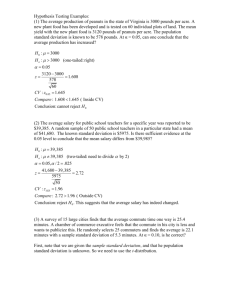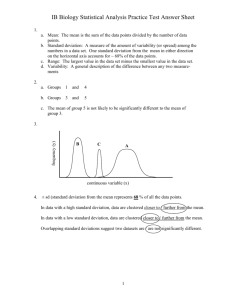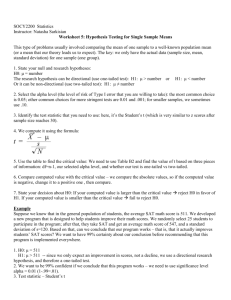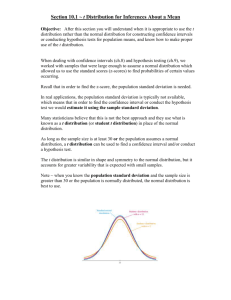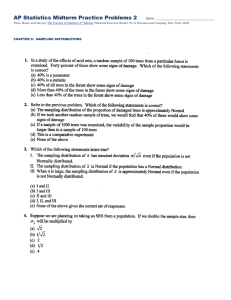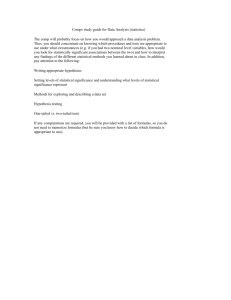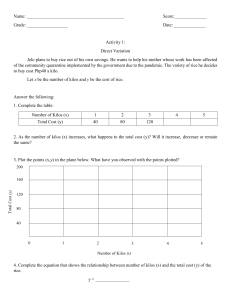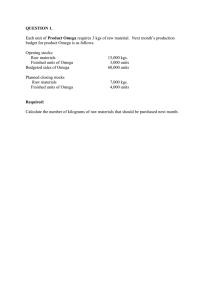FINAL EXAM - MABC 512 Advanced Statistics with Computer
advertisement
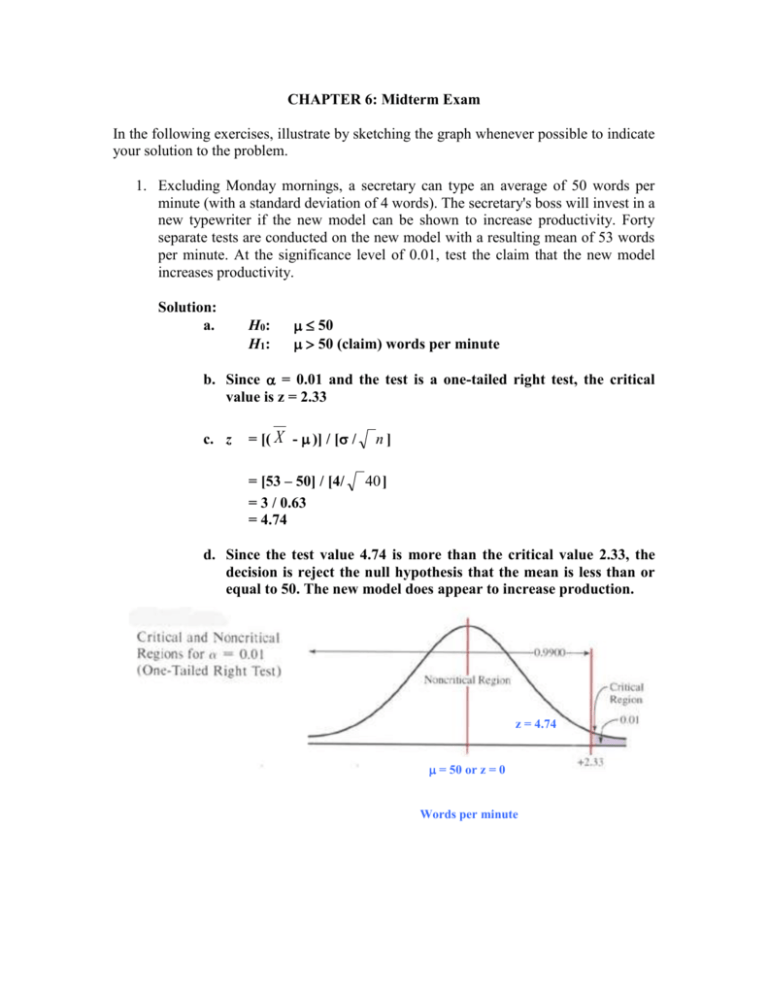
CHAPTER 6: Midterm Exam In the following exercises, illustrate by sketching the graph whenever possible to indicate your solution to the problem. 1. Excluding Monday mornings, a secretary can type an average of 50 words per minute (with a standard deviation of 4 words). The secretary's boss will invest in a new typewriter if the new model can be shown to increase productivity. Forty separate tests are conducted on the new model with a resulting mean of 53 words per minute. At the significance level of 0.01, test the claim that the new model increases productivity. Solution: a. H0 : H1 : 50 50 (claim) words per minute b. Since = 0.01 and the test is a one-tailed right test, the critical value is z = 2.33 c. z = [( X - )] / [ / = [53 – 50] / [4/ = 3 / 0.63 = 4.74 n] 40 ] d. Since the test value 4.74 is more than the critical value 2.33, the decision is reject the null hypothesis that the mean is less than or equal to 50. The new model does appear to increase production. z = 4.74 = 50 or z = 0 Words per minute 2. A local brand sugar is packaged in plastic bags labeled 5 kilos. One hundred packages are randomly selected and measured. The sample mean and standard deviation are found to be 4.95 kilos and 0.15 kilo, respectively. At the 0.01 significance level, test the claim that the sample comes from a population which the mean weight is less than 5 kilos. Assume that the sample standard deviation can be used for the population standard deviation. Solution: a. H0 : 5 kilos H1 : 5 kilos (claim) b. Since = 0.01 and the test is a one-tailed left test, the critical value is z = - 2.33 c. x = / = 0.15 / = 0.015 100 Z = ( X - x) / x = (4.95 – 5) / 0.015 = - 0.05 / 0.015 = - 3.33 d. Since the test value – 3.33 is less than the critical value - 2.33, the decision is reject the null hypothesis that the mean is greater than or equal to 5 kilos. The sample data support the claim that the mean weight is less than 5 kilos. z = - 3.33 = 5 or z = 0 Kilos of sugar per bag 3. At the significant level of 0.03, test the claim the following I.Q. scores come from a special group in which the mean is above 100. Use the sample standard deviation as an estimate for the population standard deviation. Solution: X 101 107 107 110 90 89 114 91 105 105 99 130 79 95 106 144 117 103 111 93 100 99 103 118 101 120 98 107 82 101 103 123 82 112 Total 3545 (X - X ) -3.3 2.7 2.7 5.7 -14.3 -15.3 9.7 -13.3 0.7 0.7 -5.3 25.7 -25.3 -9.3 1.7 39.7 12.7 -1.3 6.7 -11.3 -4.3 -5.3 -1.3 13.7 -3.3 15.7 -6.3 2.7 -22.3 -3.3 -1.3 18.7 -22.3 7.7 -1.2 (X - X )2 10.9 7.3 7.3 32.5 204.5 234.1 94.1 176.9 0.5 0.5 28.1 660.5 640.1 86.5 2.9 1576.1 161.3 1.7 44.9 127.7 18.5 28.1 1.7 187.7 10.9 246.5 39.7 7.3 497.3 10.9 1.7 349.7 497.3 59.3 6054.7 s2 = (X- X ) / (n-1) = 6054.7 / [34 – 1] = 6054.7 / 33 = 183.47 s = s2 = 183.47 = 13.54 or 13.5 a. H0 : H1 : 100 100 (claim) I.Q. scores d. Since = 0.03 and the test is a one-tailed right test, the critical value is z = 1.88 e. x = / = 13.5 / 34 = 13.5 / 5.83 = 2.315 Z = ( X - x) / x = (104.3 – 100) / 2.315 = 4.3 / 2.32 = 1.853 or 1.86 f. Since the test value 1.86 is less than the critical value 1.88, the decision is not to reject the null hypothesis that the mean is less than or equal to 100. The sample data do not support the claim that the mean is above 100. Critical and Noncritical Regions for = 0.03 One-Tailed Right Test 0.9700 = 0.03 = 5 or z = 0 1.88 z= 1.86 I. Q. scores 4. A sociologist designs a test to measure prejudicial attitudes and claims the mean population score is 60. The test is then administered to 28 randomly selected subjects and the results produce a mean and standard deviation of 69 and 12, respectively. At the 5% level of significance, test the sociologist's claim. a. H0: = 60 (claim) test score H1: 60 b. Since = 0.05 and the test is a two-tailed test, the critical value is t = - 0.025 and 0.025 c. t = ( X - ) / (s / = [69 – 60] / [12/ = 9 / [12 / 5.29] = 9 / 2.26 = 3.968 or 3.97 ) 28 ] d. In this two-tailed test, the critical value of - 2.052 and 2.052 is found from the table using DF = 28 – 1 = 27 and = 0.05 e. Since the test statistic of t = 3.97 does not fall in the critical region, we reject the null hypothesis mean = 60. f. The mean appears to be different from 60 test score. 3.97 belongs to the non-critical region Finding the Critical Values for = 0.05 Two-Tailed Test 0.9500 0.025 0.025 0.475 = 60 or z = 0 Test scores 5. Test the claim that the mean female reaction to a highway signal is less than 0.70 second. Eighteen females are randomly selected and tested; their mean is 0.668 second. Assume that the population standard deviation is 0.10 second and use a 5% level of significance. a. H0: > 0.70 (claim) test score H1: 0.70 b. Since = 0.05 and the test is a left-tailed test c. t = ( X - ) / (s / ) = [0.668 – 0.70] / [0.10 / 18 ] = [0.668 – 0.70] / [0.10 / 4.24] = - 0.032 / 0.023 = - 1.357 or - 1.36 d. In this left-tailed test, the critical value of 1. 645 is found from the table. e. Since the test statistic of t = - 1.36 does not fall in the critical region, we do not reject the null hypothesis that the mean is greater than or 0.70. The data do not support the claim that the mean is less than 0.70 second. Critical value and critical region 0.05 0.4500 - 0.136 = 0.70 or z = 0 Seconds

